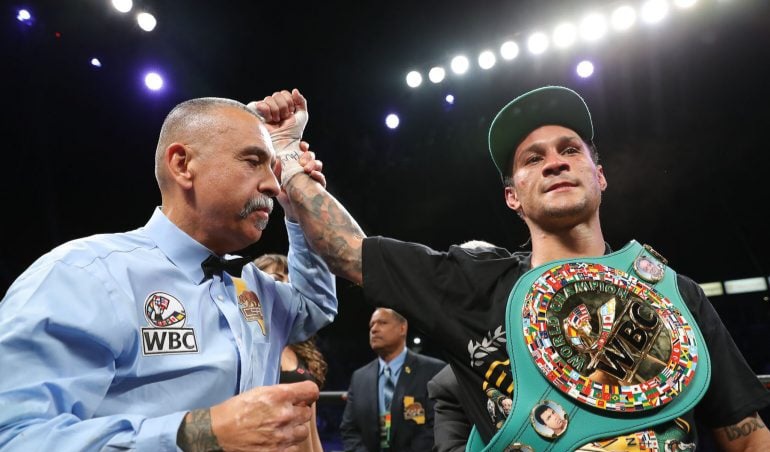
Regis Prograis loves to study. When he first started boxing, ultimately turning pro late by modern standards at 23, he concluded that one way he could get a leg up on the competition was to read voraciously, like one of his early idols Mike Tyson did. A few years back, Prograis said he had over 300 books in his house, and had read them all. Some were about boxing, learning more about his favorite fighters like Henry Armstrong, Joe Gans, Marvin Hagler and Sugar Ray Leonard. Others were about finance, or civil rights leaders, like the Malcolm X biography he read on the flight from Los Angeles to Dubai before he knocked out Tyrone McKenna earlier this year.
Prior to his WBC super lightweight title bout against Jose Zepeda on Saturday, Prograis said that it felt as though he had been preparing for the fight for three years. In 2019, Prograis lost his world title in a unification bout against Josh Taylor in the finals of the World Boxing Super Series, and since then, he said it felt like he was “crawling out of a pit.” He studied his potential competition, those who might be in the way on his path to becoming champ again. So by the time it was announced that Zepeda would be his opponent with a vacant title on the line, he was very sure that he was “on a different level” than Zepeda.
As certain as he was, Prograis can never be too prepared or too informed. The moment it was clear he was in line for the Zepeda fight, he started camp specifically for him, after previously thinking he would be facing Viktor Postol late this year. In essence, he had a six month training camp, ensuring peak readiness strategically, but also avoiding the pesky weight issues that had plagued him in the past. Prograis’ old school approach to weight cutting needed some updating as well, and after a mock weight cut and the hiring of a nutritionist, even his mother’s gumbo which he got to enjoy during his first weeks of camp in New Orleans, couldn’t throw him off-track.
“Nothing better than having my baby boy back at home,” Prograis’ mother Sherita told Ted Lewis of Nola.com. “This is the longest he’s been here that I can remember. I’m not worried about him getting too fat though. He knows what he needs to do.”
Prograis indeed knew everything he had to do against Zepeda, coming out in round one with the demeanor and posture of someone who had thoroughly prepared for the exam. Eyes wide, body relaxed, slipping and sliding in the pocket past Zepeda’s offerings, stinging him again and again with sharp leads and counters. As would be expected in a world title fight, he of course didn’t swim without getting wet. He had to battle through a bloody nose, and admitted that Zepeda was quicker in the ring than he had been on film.
But the fighters Prograis has formed himself in the mold of weren’t ones who avoided contact, so much as they learned how to absorb it, ride with it and use it to their advantage. His in-ring idols like Armstrong and Roberto Duran could be great defenders, but their aggression welcomed a certain amount of punishment under the premise that they would inflict more.
Aesthetically, Prograis resembles a fighter from a bygone era in the ring. Like any martial art, or art for that matter, boxing has evolved over time and the techniques of yesteryear are carried over, adapted and built upon as generations have gone by.
The older cast of contemporary boxers often cites Tyson, Roy Jones or Oscar De La Hoya as their entry point in boxing. Fighters younger than them might cite Floyd Mayweather or Manny Pacquiao. Those just breaking into the pro ranks often cite Canelo Alvarez. It’s not an accident that a lot of modern boxing bares some resemblance in approach to these giant figures, as those fighters are the most common reference point for the athletes. But like a musician who purposely taps into a particular decade’s sound, or strips down their arrangement to better resemble a previous era’s style, it’s clear that Prograis is influenced by a footage much older than the YouTube videos many contemporary fighters tend to study.
Just as you can turn on a Carly Rae Jepsen album and say “she’s been listening to 80s synth pop,” you can turn on a Prograis fight and know immediately that he’s been deep into the Jim Jacobs film archives.
In 2017, Sarah Deming wrote for StiffJab that “Prograis fights like he wants everyone in the room to have a great time except (his opponent).” There’s a looseness and playfulness to his offense, as he breaks at the waist and uses upper body movement to evade punches and create unusual angles. With his lead hand down, he shuffles and glides around the ring, a brand of quiet slippery footwork that characterized the smooth boxers of the 1940s and 50s. To close the show against Zepeda, he put it all together, gliding to his right and goading a reaction out of Zepeda as he hit him with a drive-by left hand that sent him into disarray. Prograis pounced on Zepeda immediately and nearly sent him through the ropes in a frenzied flurry that caused referee Ray Corona to wave the fight off.
As an avid reader like Prograis knows, a three-year odyssey deserves a dramatic ending.
By Corey Erdman
